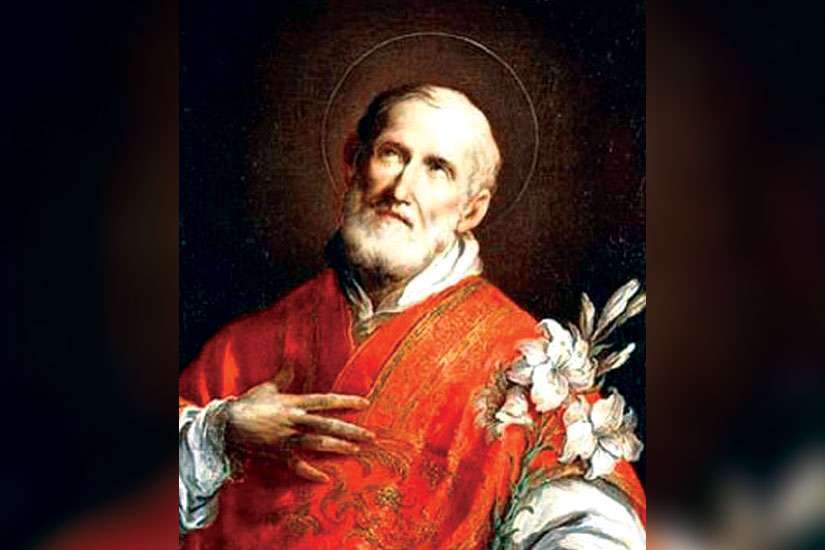Now joining this gallery of portrayals is Fr. Jonathan Robinson’s In No Strange Land: the Embodied Mysticism of Saint Philip Neri (Angelico Press, $26.11), a depiction of the man for the 21st century.
We admire public people nowadays (when we can find them) who are capable, self-possessed, at ease among the powerful, yet wholly at home with ordinary folk. (The late Jack Layton comes to mind.) So we like the Philip Neri we meet in these pages; it would be difficult not to. He “was not a reformed rake, but neither was he a figure out of the world of stained glass,” Robinson says; “he was a man of flesh and blood…” — intelligent, blessed with organizational savvy, cultivated, devoted to beauty and ironic.
Goethe compliments Philip on being a “humorous saint.” He was one, and all the other things I’ve mentioned; yet that is not all he was. Those who knew him during the years in Rome — from around 1533, when he was in his late teens, until his death in 1595 — remembered his vigorous holiness and the transfigured humanity that made his counsel, leade rship and witness to the things of God famous in the city and beyond. Robinson is unembarrassed by the physical manifestations of grace that marked St. Philip’s body and ministry; we should be, too.
But for the author, superior of the Toronto Oratory, his society’s founder was and is more than a remarkable instance of sanctity. He is one of the rare Christians to whom the Lord has opened the God-ward way usually called “mysticism,” or (better) “enlightenment that bursts forth into love” (Thomas Aquinas, quoted here.)
“I am convinced,” we read, “that (St. Philip’s) mysticism is the source of his perennial fascination and enduring influence.” It was rooted in “the ordinary practices of his Catholicism,” which, in turn, “were profoundly influenced by their development within the historical, social and, more narrowly, religious environment of late 15th-and early 16th-century Florence and Rome.” Mobilizing the known and probable facts of St. Philip’s education, spiritual formation and public career, the author shows how an ancient mystical schedule — first comes purgation, then illumination and finally union with the Trinity — was “embodied” in the concrete circumstances of one Italian Catholic deeply implicated in Renaissance culture.
The result, however, is not a new Life. Though he frequently takes issue with his sources and comes up with original interpretations, Robinson does not aim to displace the standard modern biography of the saint, written 100 years ago by the French priests Louis Ponnelle and Louis Bordet. His work is best read, rather, as a series of theological and philosophical reflections, laced with selective biographical and historical detail, on what St. Philip was, and what he meant in his time and can mean in ours.
The book is laid out in three main parts, each corresponding to a phase of St. Philip’s three-fold mystical trajectory. The forward thrust of these sections is often stalled by digressions — sometimes intriguing notes on the saint’s cultural and political milieu, though sometimes needless repetitions of points made earlier, or fields on which to re-fight old philosophical battles that have little to do with Philip. (Robinson was a professor of philosophy at McGill.)
I leave it to people with the appropriate training to adjudicate Robinson’s case against Descartes and his arguments with Hegel. But even without these interludes, his book would be intellectually demanding. It will be most enjoyed, I suspect, by people familiar with the literature on “mysticism,” and by Christians who, in common with this reviewer — an eclectically educated Catholic layman — downright like to read about saints and slog through hard works by contemporary Christian thinkers such as Denys Turner, David Bentley Hart and John D. Caputo.
Readers in search of Philip Neri will surely find him here, refreshed and vivid. His story, Robinson maintains, addresses a question that troubled believers in 16th-century Rome, and that haunts the Church today: How can we tempt secularized, modernized humankind, and the baptized but post-Christian multitudes, to taste and see that the Lord is good?
“Part of the answer,” writes Robinson, “is that the glory of God breaks through the carapace of unbelief and indifference by means of the holiness of the saints…. Sanctity is something lived, and the lives of the saints are important because in the end, as Newman said, it is people we trust and not arguments.”
(Mays is a freelance writer in Toronto.)

